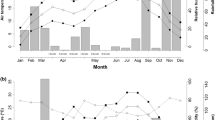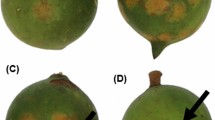Abstract
Bacterial leaf spot incited by Xanthomonas campestris pv. mori is a devastating foliar disease of mulberry reported globally. Host plant resistance is the most sustainable and economic control measure but so far unexplored. Highly heterozygous plant behaviour and scant genetic information of bacterial leaf spot resistance limits a targetted breeding approach in mulberry. In the present research eight pseudo-F2(F1)full-sib progenies derived from selected resistant and susceptible sources were evaluated symptomatically for bacterial leaf spot resistance under natural disease occurrence in 2008 and 2009. Significant variation for bacterial leaf spot resistance was observed in the parents and progenies. Broad sense heritability estimate (0.9) indicates that selection of resistant genotypes can be useful for exploitation in future advanced breeding programs for mulberry. High narrow sense heritability estimates (0.76)[2008] and (0.79)[2009] suggest additive gene effects for the disease resistant trait. The continuous frequency distribution of diseases severity across the progenies indicates that bacterial leaf spot resistance in mulberry may be inherited quantitatively.



Similar content being viewed by others
References
Allard, R. W. (1999). Principles of plant breeding. New York: Wiley.
Aravanopoulos, F. A. (2010). Contribution of leaf morphometrics in the study of genetic entries in Salix L. Electronic Journal of Plant Breeding, 1, 1320–1328.
Banerjee, R., Das, N. K., Maji, M. D., Mandal, K., & Bajpai, A. K. (2009). Screening of mulberry genotypes for disease resistance in different seasons to bacterial leaf spot. Indian Journal of Genetics, 69, 292–296.
Banerjee, R., Maji, M. D., Ghosh, P., & Sarkar, A. (2009). Genetic analysis of disease resistance against Xanthomonas campestris pv.mori in mulberry (Morus spp.) and identification of germplasm with high resistance. Archives of Phytopathology and Plant Protection, 42, 291–297.
Ben-Hui Leu. (1997). Statistical genomics linkage, mapping and QTL analysis. Introduction to genomics. (pp. 59–60). CRC press: LLC.
Bisognin, D. A., Douches, D. S., Jastrzebski, K., & Kirk, W. W. (2002). Half-sib progeny evaluation and selection of potatoes resistant to the US8 genotype of Phytopthora infestans from crosses between resistant and susceptible parents. Euphytica, 125, 129–138.
Bokmeyer, J. M., Bonos, S. A., & Meyer, W. A. (2009). Inheritance characteristics of brown patch resistance in tall fescue. Crop Science, 49, 2302–2308.
Bonos, S. A. (2006). Heritability of dollar spot resistance in creeping bentgrass. Phytopathology, 96, 808–812. doi:10.1094/PHYTO-96-0808.
Bonos, S. A. (2011). Gene action of dollar spot resistance in creeping bentgrass. Journal of Phytopathology, 159, 12–18.
Bonos, S. A., Casler, M. D., & Meyer, W. A. (2003). Inheritance of dollar spot resistance in creeping bentgrass. Crop Science, 43, 2189–2196.
Bovi, M. L. A., Deresende, N. D. V., Saes, L. A., & Uzzo, R. P. (2004). Genetic analysis for sooty mold resistance and heart of palm yield in Archontophoenix. Science Agriculture (Piracicaba, Braz.), 61, 178–184.
Burruezo, A. R., Prohens, J., & Nuez, F. (2003). Performance of hybrid segregating populations of pepino(Solanum muricatum) and its relation to genetic distance among parents. The Journal of Horticultural Science and Biotechnology, 78, 911–918.
Burton, G. W., & Devane, E. H. (1953). Estimating heritability in tall fescue(Festuca arundinaccea) from replicated clonal material. Agronomy Journal, 45, 478–481.
Dandin, S. B., & Giridhar, K. (2010). Handbook of sericulture technologies. In (4th Ed), Mulberry diseases and pests-control measures (pp. 157–158). Bangalore, India: Central Silk Board.
Dandin, S. B., Jolly, M. S., Susheelamma, B. N., Mallikarjunappa, R. S., Sastry, C. R. (1983, March). Evaluation and utilization of existing genetic variability in mulberry. (Paper presented at the National Seminar on Silk Research and Development, Bangalore, India).
Das, B. C. (1984). Mulberry varieties, exploitations and pathology. Sericologia, 24, 369–372.
Das, B. C., & Krishnaswami, S. (1965). Some observations on interspecific hybridization in mulberry. Indian Journal of Sericulture, 4, 1–8.
Dudley, J. W., & Mole, R. H. (1969). Interpretation and use of heritability and genetic variances in plant breeding. Crop Science, 9, 257–262.
Ertian, H. (2003). Protection of mulberry plants (translated from Chinese). New Delhi: Oxford and IBH publishing Co Pvt Ltd.
Fain, P. R. (1978). Characteristics of simple sib-ship variance tests for detection of major loci and application to height, weight and spatial performance. Annals of Human Genetics, 42, 109–120.
Falcconer, D. S., & Mackay, T. F. C. (1996). Introduction to quantitative genetics. Essex: Longman Group Ltd.
Fehr, W. R. (1987). Principles of cultivar development, vol.1. Theory and technique. New York: Macmillan Publishing Co.
Guimaraes, L. M. S., Resende, M. D. V., Lau, D., Rosse, L. N., Alves, A. A., & Alfenas, A. C. (2010). Genetic control of Eucalyptus urophylla and E. grandis resistance to canker caused by Chrysoporthe cubensis. Genetics and Molecular Biology, 33, 525–531.
Han, Y., Bonos, S. A., Clarke, B. B., & Meyer, W. A. (2006). Inheritance of resistance to grey leaf spot disease in perennial ryegrass. Crop Science, 46, 1143–1148.
Horsefall, J. G., & Cowling, E. B. (1978). In J. G. Horsefall & E. B. Cowling (Eds.), Plant disease (pp. 120–136). New York: Academic.
Johnson, H. W., Robinson, H. F., & Comstock, R. E. (1955). Estimates of genetic and environmental variability in soybean. Agronomy Journal, 47, 314–318.
Jorge, V., & Verdier, V. (2002). Qualitative and quantitative evaluation of cassava bacterial blight resistancein F1 progeny of a cross between elite cassava clones. Euphytica, 123, 41–48.
Kim, H. S., Sneller, C. H., & Diers, B. W. (1999). Evaluation of soybean cultivars for resistance to Sclerotia stems rot in field environments. Crop Science, 39, 64–68.
Kitchen, L. A. (1998). Exploring statistics. In (2nd Ed), A modern introduction to data analysis and inference. Pacific Grove: CA Duxbury Press.
Klein, J. I. (1998). A plan for advanced-generation breeding of jack pine. Forest Genetics, 5, 73–83.
Kore, S. S., & Patil, P. S. (1985, January). Investigations of bacterial blight disease of mulberry (Morus alba L.) (Paper presented in the 37th Annual Meeting of Indian Phytopathological Society, New Delhi).
Lush, J. L. (1949). Heritability of quantitative characters in farm animals. Hereditas (Suppl.), 35, 356–357.
Lynch, M., & Walsh, B. (1998). Genetics analysis of quantitative traits. Sunderland: Sinauer Associates, Inc.
Maji, M. D., Kadri, S. M. H., & Pal, S. C. (2000). Control of bacterial leaf spot of mulberry caused by Xanthomonas campestris pv. mori. Indian Journal of Sericulture, 38, 81–83.
Maji, M. D., Sau, H., Das, B. K., & Urs, S. R. (2006). Screening of some indigenous and exotic Mulberry Varieties against major foliar fungal and bacterial diseases. International Journal of Industrial Entomology, 12, 35–35.
Maji, M. D., Banerjee, R., Das, N. K., Chakrabarty, S., Bajpai, A. K. (2008). Role of meteorological factors on the incidence of mulberry diseases. Journal of Agrometeorology, Special Issue-Part I, 193–196.
Majidi, M. M., Mirlohi, A., & Amini, F. (2009). Genetic variation, heritability and correlations of agro-morphological traits in tall fescue (Festuca arundinaceae Schreb.). Euphytica, 167, 323–331. doi:10.1007/s10681-009-9887-6.
McKinney, H. H. (1923). Influence of soil temperature and moisture on infection of wheat seedlings by Helminthosporium sativum. Journal of Agricultural Research, 26, 195–210.
Mohan, M., Nair, S., Bhagwat, A., Krishna, T. G., Yano, M., Bhatia, C. R., et al. (1997). Genome mapping, molecular markers and marker assisted selection in crop plants. Molecular Breeding, 3, 87–103.
Nagaraj, M. S., Srinivasachary, & Khan, A. N. A. (2000). National seminar on tropical sericulture. In K. P. Chinnnaswamy, R. Govindan, N. K. Krishnaprasad, & D. N. R. Reddy (Eds.), Growth requirements of Xanthmonas campestris pv.moricola causing bacterial blight in mulberry (pp. 124–126). Bangalore: University of Agricultural Sciences, GKVK.
Owolade, O. F. (2006). Line x Tester analysis for resistance to cassava anthracnose disease. World Journal of Agricultural Sciences, 2, 109–114.
Philip, T., Govindaiah, Bajpai, A. K., Nagabhushanam, G., & Naidu, N. R. (1997). A preliminary survey on Mulberry disease in South India. Indian Journal of Sericulture, 36, 128–132.
Poehlman, J. M., & Sleper, D. A. (1995). Breeding field crops. Ames: Iowa State University Press.
Ravikumar, M. R., Prakash, B. G., & Samarao, J. (2004). Report on bacterial blight in mulberry from northern Karnataka and its management. Sericologia, 44, 381–383.
Sato, M., & Takahashi, K. (1973). Rough colony mutant of Pseudomonas mori(Boyer et Lambert)Stevens. Annals of the Phytopathology Society of Japan, 39, 425–428.
Sharma, D. D., Chowdary, N. B., Naik, N., Rajan, M. V., & Dandin, S. B. (2005). Blight diseases of mulberry (Morus spp.)—a review. Sericologia, 45, 25–231.
Sinha, S. K., & Saxena, S. F. (1966). First record of bacterial blight of mulberry in India caused by Pseudomonas mori(Boyer et Lambert)Stevens. Indian Phytopathology, 19, 318–319.
Tulsieram, L. K., Glaubitz, J. C., Kiss, G., & Carlson, J. E. (1992). Single tree genetic linkage mapping in conifers using haploid DNA from megagametophyte. Nature Biotechnology, (NY), 10, 686–690.
Vijayan, K., Chauhan, S., Das, N. K., Chakroborti, S. P., & Roy, B. N. (1997). Leaf yield component combining abilities in mulberry(Morus spp.). Euphytica, 98, 47–52.
Acknowledgements
The authors duly acknowledge Mr. P Dey and Mr. T Maitra for providing technical assistance.
Author information
Authors and Affiliations
Corresponding author
Rights and permissions
About this article
Cite this article
Banerjee, R., Das, N.K., Doss, S.G. et al. Narrow sense heritability estimates of bacterial leaf spot resistance in pseudo F2 (F1) population of mulberry (Morus spp.). Eur J Plant Pathol 133, 537–544 (2012). https://doi.org/10.1007/s10658-011-9894-z
Accepted:
Published:
Issue Date:
DOI: https://doi.org/10.1007/s10658-011-9894-z




